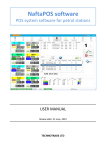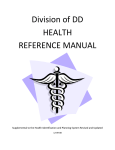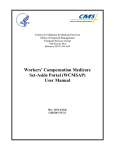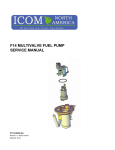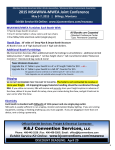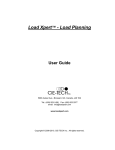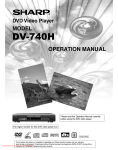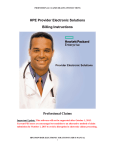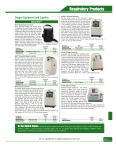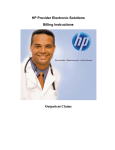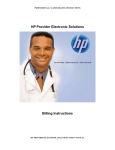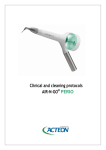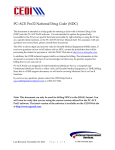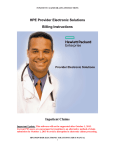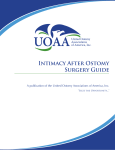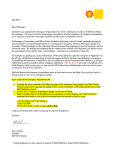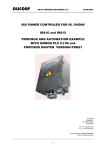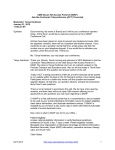Download Jurisdiction B Council October 12, 2010 Q And
Transcript
Jurisdiction B Council A-Team Questions Sorted by A-Team October 12, 2010 Disclaimer National Government Services, Inc. has produced this material as an informational reference for providers furnishing services in our contract jurisdiction. National Government Services employees, agents, and staff make no representation, warranty, or guarantee that this compilation of Medicare information is error-free and will bear no responsibility or liability for the results or consequences of the use of this material. Although every reasonable effort has been made to assure the accuracy of the information within these pages at the time of publication, the Medicare program is constantly changing, and it is the responsibility of each provider to remain abreast of the Medicare program requirements. Any regulations, policies and/or guidelines cited in this publication are subject to change without further notice. Current Medicare regulations can be found on the Centers for Medicare & Medicaid Services (CMS) Web site at http://www.cms.gov. Home Medical Equipment 18. Please provide documentation requirements as well as proper billing instructions for HCPCS code E0217 (heat therapy pump with pad). I have researched documentation guidelines and can only find a draft policy last modified 10/02/2009 that states "The medical necessity for a moist electric heating pad (E0215) or water circulating heat pad with pump (E0217) compared to a standard electric heating pad (E0210) has not been established. Therefore, if one of these devices is provided and basic coverage criteria are met, payment will be based on the allowance for a standard electric heating pad." We have received requests from customers as well as physicians asking us to deliver this equipment. Please advise if the above policy remains in effect and the E0217 will be down coded (as long as basic coverage criteria have been met) to the standard electric heating pad. ANSWER: The statement from the 2008 draft policy is still an accurate reflection of the DME MAC assessment of the water circulating heat pad with pump, E0217 – i.e., that it has no proven advantage to a standard heating pad for use in the home setting. Enteral/Parentral/IV Therapy 19. Would it be appropriate for a provider to round up to the nearest whole number when billing for A4221 (Supplies for maintenance of drug infusion catheter, per week)? For example, if a provider ships 18 days of catheter care maintenance supplies should the provider bill for 2 units or 3? ANSWER: For a one time shipment, if a supplier provides 18 days of infusion supplies, it would be acceptable to bill 3 units of service. However, if there are further deliveries of supplies, there should be no billing for the 3 days of supplies that would make up the balance of the 3 units of service that were billed with the first claim – i.e., if the second shipment was for 17 days of supplies, only 2 UOS would be billed. Respiratory Care Equipment/Oxygen Therapy 20. Patient rented for 11 months PAP (E0601) returned AMA, restudied qualifies and set up again. We know we will only get 2 more months of rental, so do we need a 31-90 day follow-up? We realize we wouldn’t be reaching a 3rd month billing on the equipment itself, but require answer for ongoing supplies and ability to add the KX modifier. ANSWER: In the scenario described (i.e., no break in medical necessity), if the patient met both the initial and continued coverage criteria for the original 11 month’s use of the PAP device, neither a repeat sleep study nor repeat documentation of compliance would be required in order to cover the remaining 2 rental months for the device and ongoing coverage for accessories. 21. Patient has been on covered E0470 for over 60 months and the unit is now broken beyond repair. Replacement E0470 is issued; do we have to have a doctor statement for the 61-90 days? The policy says we need prescription and face-to-face evaluation and no other documentation is needed. ANSWER: The policy states that for replacement following the 5 year Reasonable Useful Lifetime (RUL), “there is no requirement for a new sleep test or trial period.” 22. In the current PAP LCD, there is a requirement for patients whose PAP devices were originally obtained and covered through Medicare. It states “If a PAP device is replaced following the 5 year RUL, there must be a face-to-face evaluation by their treating physician that documents that the beneficiary continues to use and benefit from the PAP device. There is no requirement for a new sleep test or trial period.” Must the face-to-face evaluation be conducted before the patient’s PAP device is replaced? ANSWER: Yes. 23. Is a specific dispensing order required for portable oxygen? Patients are typically provided with portable oxygen at hospital discharge, but the home oxygen order typically reads "oxygen (X) liters per nasal cannula". The need for portable oxygen is indicated on the initial CMN. ANSWER: A physician’s order, from the treating physician, is required before an item is dispensed. The dispensing order may be a preliminary written order (original, fax, or electronic) or a verbal order (taken by phone) from the doctor. A documentary record of the order must be kept on file. A dispensing order must include the following: The beneficiary’s name A description of the item The physician’s name The date of the order Please refer to the Jurisdiction B Supplier Manual, chapter 8 for additional information regarding orders. 24. Does the beneficiary or beneficiary representative need to sign the delivery ticket if portable oxygen tanks are left on the beneficiary's porch during the rental period? ANSWER: Delivery documentation must show that an item was actually provided to a specific beneficiary. When delivering an item directly to the beneficiary, it is recommended that proof of delivery be documented by a delivery slip, signed and dated by the beneficiary or his or her authorized representative. Please refer to the Jurisdiction B Supplier Manual, chapter 8 for further information on proof of delivery requirements. 25. The oxygen LCD (L27221 Effective 01/01/2010) indicates that a condition for home oxygen coverage is "Alternative treatment measures have been tried or considered and deemed clinically ineffective." Please provide examples of acceptable "alternative treatment measures." ANSWER: Alternative treatment measures would involve optimization of treatment for the underlying condition. Some examples (not all-inclusive) might be: stopping smoking, using inhalation drugs, engaging in a pulmonary rehabilitation program, etc. 26. New clarification for PAP to RAD: What is the suppliers risk between the April 1 and August 1 time frame. In essence providers have treated patients’ qualifications differently during that time frame. Why wasn’t the effective date not made 4/1/2010? ANSWER: The revised wording that was published in August was just another way of stating the principles that initially became effective on April 1, 2010. Prosthetics/Orthotics 27. The External Breast Prosthesis policy was recently updated with the following information: “A supplier must not dispense more than a 3-month quantity of supplies and accessories at a time.” The policy states what quantities are allowed for forms but does not indicate quantities for L8015 (camisoles) or L8000 (bras). Could you please let us know what constitutes a 3 month supply for the L8015 or L8000? ANSWER: Dr. Oleck is working with the other Medical Directors and we will respond to this question as soon as he receives the information. Rehab Equipment 28. We have been filing claims for HCPC E2210 (Bearings) with a quantity of 12, but we are only getting paid on a quantity of 2. We have spoken to customer service many times regarding this issue but the problem continues. Are there limitations to quantities for this code? ANSWER: Claims examples were received and the DME MAC is currently researching the issue. The DME MAC will follow-up with the individual supplier with the findings of the examples provided. 29. Please discuss using pediatric vs. adult codes for wheelchairs in these situations: (1) the client is an adult, needs a seat width/depth greater than 14" but the 'best' wheelchair for the beneficary is coded by the Pricing, Data Analysis, and Coding Contractor (PDAC) only as a pediatric base. Should this be provided and billed using the pediatric code? Or should the appropriate 'adult' base code be used, since the seat width/depth qualifies as adult size? (2) the client is an adult, needs a seat width/depth less than 14" but the wheelchair base is coded by PDAC only as an 'adult' code. Can this be billed using the adult base code, even if provided with a smaller size? 30. ANSWER: For manual wheelchair bases, coding verification review by the PDAC is not required. Therefore, for manual wheelchair bases, if the seat width is 15” or more, one of the adult WC base codes should be used, even if it is not listed in the Durable Medical Equipment Coding System (DMECS). Seat width is not a determining factor in the coding of power wheelchair bases. 31. If a clinic who performs a specific wheelchair evaluation and completes their own formal document adds a statement saying that "Joe Smith, ATP of ABC Medical was present at this evaluation" would this meet the criteria to show that the ATP was involved in the wheelchair selection process? ANSWER: There should also be at least a brief note from the supplier ATP. Ostomy/Urological/Medical Supplies No Questions Submitted. Diabetic Monitoring and Supplies 32. We occasionally receive a prescription that advises the patient is either IDDM status or NIDDM status (insulin or non insulin dependent). Accordingly we apply the KX or KS modifier to claims. At some point later through requesting medical records, we observe that the patient’s insulin status has changed without our awareness. While we have attempted to have claims reopened to correct the modifier, there have been a few occasions where we have had to go beyond the re-openings limitation of 12 months. What is the correct course of action to take in correcting claims for this modifier error while trying to avoid a timely filing limitation (i.e. refund/rebill)? ANSWER: If you determine the beneficiary’s insulin status has changed and the patient is no longer insulin dependent an overpayment will more than likely have occurred. In this situation, you should submit a voluntary refund request for the overpaid amount. However, if the scenario is reversed and the patient was previously non insulin dependent and now they are insulin dependent more than likely an underpayment would have occurred. Therefore, a reopening would be needed in order for the supplier to receive additional payment. Generally, reopenings must be requested within 12 months of the final determination. However, in some situations where “good cause” is established a claim determination can be reopened up to 4 years from the final claim determination. Documentation/Regulatory/Miscellaneous/Other 33. We have been noticing an increase in processing errors by Jurisdiciton B. Below are examples. When we call and speak with customer service we are told that all of our information was received with the electronic file, which means the error is not on our end. What is being done to correct these issues? When billing more than 4 modifiers on a claim line we are including “99” as our 4th modifier and then adding ALL modifiers to the HAO record. Our claims are being processed with some but not all of the modifiers. Some of the modifiers processed were ONLY listed in the HAO record so NGS is receiving them. Why are some modifiers being missed? ANSWER: On June 14, 2010 supplemental training was provided to the claims processing staff regarding the processing of claims which involved more than 4 modifiers. However, it was identified that there are still some issues surrounding these claims, so additional supplemental training will be provided to the claims processing staff in the next two weeks. We continue to receive payment on some items where we have used the GA modifier and have NOT added the KX (which is required per policy) because the beneficiary does not qualify and a properly executed ABN was signed. What is our liability if we do not catch National Government Services payment error? ANSWER: The examples submitted are currently being researched. We also continue to receive CO-50 denials on items where we had added the GY modifier to indicate that the item is statutorily excluded. Shouldn’t Medicare be denying these claims as PR-50 instead? Our only reason for filing was to have a valid denial for the secondary insurance billing purposes. ANSWER: An update was made to the Medicare claims processing system shortly after the claim example that was provided, processed and paid. Claims submitted with the GY modifier should now deny with ANSI denial code PR-50. An example of both an incorrect payment and an incorrect denial happened on the same claim: We billed 2 units of E2365 with modifiers NURAGY. Medicare did NOT pay for the PMD because it was not being used inside the home yet we initially received payment on the E2365. We contacted National Government Services and they confirmed that the claim was filed correctly and should not have been paid. National Government Services initiated a recoupment. We then received an EOMB for the same item, same date of service, same HCPC and modifiers but this time it was denied with a CO-50 instead of the appropriate PR-50. ANSWER: An update was made to the Medicare claims processing system shortly after the claim example that was provided, processed and paid. Claims submitted with the GY modifier should now deny with ANSI denial code PR-50. 17. What should suppliers do in order to protect themselves when they provide replacement equipment because the prior equipment is lost, stolen, irreparably damaged or past the 5-year RUL? ANSWER: Medicare allows for the payment of replacement equipment provided the original item is lost, stolen, irreparably damaged or when the item has reached the 5-year RUL. When replacing an item is lost, stolen, irreparably damaged, or when the item has reached the 5year RUL, the supplier must submit the claim with the RA modifier and document the reason for replacement by entering a narrative explanation in Item 19 of the CMS-1500 claim form or NTE segment of the electronic claim. It would not be appropriate for a supplier to execute an ABN just in case Medicare denies the replacement equipment as same or similar. If the claim is billed appropriate with the RA modifier and narrative explanation the item should not be denied as same or similar equipment. 18. Is there any update on the face-to-face PPACA requirement for all DME? Was this required as of the signing of the bill in March or is there a different effective date for this requirement? ANSWER: Regulations on the face-to-face requirement in the PPACA are still pending. 19. Medicare supplier manual, chapter 15 under D) Labor, states: labor can be covered only if the skill of a technician is required. Does Medicare require technicians to have any certifications or specific formal training? Could you please define what you mean by “skill of a technician is required”? ANSWER: No specific certifications are required, but it is expected that the technician would have appropriate training for the services that are performed. “Skill of a technician is required” means that it is a service that would not be expected to be performed by the beneficiary or caregiver. The user’s manual for equipment usually provides information on the care for equipment that is performed by the patient. 20. Medical policy for walker does not state what documentation is needed for a seat (E0156). Can you please tell us what documentation that would justify the need for a seat, what would you look for in an audit? ANSWER: In an audit situation, we’d look for information in the patient’s medical record. One example (not all-inclusive) would be documentation indicating that the patient could not walk from one room to the next in their home without having to stop and sit down. 21. For Surgical Dressings do wounds need to be staged, IE Stage II wound, in order to be covered? We need this clarification because some wounds require multiple debridements before stage can be determined. ANSWER: Use of “stage” numbers is not required, but several categories of dressings in the policy do require documentation that the wound is full thickness or partial thickness. 22. We need clarification on the use of the RB modifier and when to use it (i.e., using it with E1399 for repairs of blower motor on CPAP unit, etc). ANSWER: National Government Services requested clarification regarding the use of the RA, RB modifiers to CMS. However, as of today we have not received a response. This is also an open action item for Council. 23. Please provide clarification on early replacement of equipment vs. repair. If a beneficiary has had a piece of durable medical equipment (i.e., wheelchair or hospital bed) for 4.5 years, and the cost of repairs would be more than 70% of the cost to replace the item, will Medicare pay for a replacement? ANSWER: No, replacement due to wear is not covered during the reasonable useful lifetime of the equipment. During the reasonable useful lifetime, Medicare does cover repair up to the cost of replacement (but not actual replacement) for medically necessary equipment owned by the beneficiary. If a Medicare beneficiary has had an oxygen concentrator for 53 months, and the cost to repair the concentrator for 53 months, and the cost to repair the concentrator is more than 70% of the cost to replace – will Medicare consider starting a new capped rental period ‘early’? ANSWER: No, it is the supplier’s responsibility to ensure the oxygen equipment rented to the beneficiary is maintained and in proper working order at all times during the 5 year reasonable useful lifetime. Therefore, suppliers must understand that they are required to provide any maintenance and servicing and repairs of the rented equipment at any time throughout the reasonable useful lifetime of the equipment. The Centers for Medicare & Medicaid Services has determined that under no circumstances would it be reasonable and necessary to pay for any maintenance and servicing or repair of supplier-owned oxygen equipment, with the exception of an in-home visit by suppliers to inspect oxygen concentrators and transfilling equipment and provide general maintenance and servicing six months after the 36-month rental cap. 24. Please clarify the information found in the Jurisdiction B Complete Supplier manual, pages 166 and 167 "Replacing Equipment Due to Reasonable Useful Lifetime". Is the correct interpretation that DME such as CPAP/BiLevel, Wheelchairs (standard), Hospital Beds, Walkers etc.... are able to be replaced under Medicare guidelines simply because they have met the 5 year RUL? Keeping in mind that the original equipment would still be the property of the customer (no real replacement as oxygen is) and, it would be the customer's decision on if they would chose to get new equipment. Also, we understand that they would still have to meet the current Medicare guidelines for the new piece of equipment. As the manual reads, putting in the narrative description for replacement "RUL" Reasonable Useful Lifetime is acceptable, leading us to believe that we are able to replace functioning, non-broken equipment when the customer requests as long as Medicare had the initial date of service at least 5 years ago and the medical need is still there (Current MD Orders). ANSWER: Yes, this interpretation is correct. Medicare does not require documentation to indicate what happened to the previous piece of equipment utilized by the beneficiary when the item has been in continuous use for the reasonable useful lifetime designated for the equipment. However, suppliers should understand that it is not necessarily “good” use of Medicare trust fund dollars to replace equipment that is in perfectly “good” working order and meets the beneficiary’s medical needs, simply because the equipment is five years old. 25. We are in receipt of an overpayment demand request for services rendered to beneficiaries from July 2008 thru December 2009. These services were rendered in good faith to patients that showed eligibility for the dates of service requested. An apparent audit has been conducted and the DME MAC has deemed these patients to have been in a hospital, hospice, SNF or ICF. This is another totally unfair mandate to the DME MAC by CMS. What is the time limit on these overpayment demands? ANSWER: The statute of limitations on Medicare overpayments is generally six years. However, the statute of limitations does not apply if there is reliable evidence that the initial determination was procured by fraud or similar fault as defined in 42 CFR §405.902. CMS needs to ensure that other agengies’ records are current and accurate. Suppliers are doing our part to ensure eligibility at the time of service/claims filing. We should not be penalized for CMS errors. Do we have any recourse? ANSWER: The Social Security Act established a Medicare prospective payment system for inpatient stays (hospital, hospice, SNF, etc.). Under the prospective payment system, durable medical equipment, prosthetics, orthotics, and supplies (DMEPOS) furnished during beneficiaries’ inpatient stays is generally included in the facility’s Medicare Part A payments. Therefore, Medicare Part B payments made by any of the four DME MACs to suppliers for such items are considered overpayments. When the inpatient facility submits their claims before DMEPOS suppliers submit theirs, prepayment edits are in place to identify and deny payments for inappropriately billed Part B services. When suppliers submit their claims prior to the inpatient facility submits their claims, postpayment edits are in place to identify Part B overpayments. 26. We do everything we can to verify if a patient is covered under a Home Health Episode before dispensing an item. Recently, we were paid for a date of service in May without the N88 code attached, then in July a subsequent claim was paid with the N88 code (paying conditionally). Therefore, I verified if the patient was in a Home Health Episode again and the IVR indicated that a Home Health Episode started in May before our initial DOS in May. I am sure eventually we will be asked to pay back our DOS in May as it falls within the time frame of Home Health Episode. I am also sure that Jurisdiction B DME MAC would not have paid us without the N88 code if they had information that the patient was in a Home Health Episode. I assume this means that the Home Health Agency did not bill the Home Health Episode, until after we had billed for our second date of service. Does anyone ever audit their documentation to determine if they actually provide the patient with supplies during the entire episode? ANSWER: Yes, Home Health Agencies are audited just like DMEPOS suppliers are audited by several different contractors which include the Recovery Audit Contractor (RAC), Zone Program Integrity Contractors (ZPIC) or Program Safeguard Contractors (PSC), and the Comprehensive Error Rate Testing (CERT) Contractor. Quality health care for people with Medicare is a high priority for the Department of Health and Human Services, and the Centers for Medicare & Medicaid Services (CMS). Why are DMEPOS suppliers being held accountable when the home health agency does not have to bill or notify Medicare there is an episode immediately? ANSWER: Under the Prospective Payment System, a Home Health Agency must bill for all home health services which includes nursing and therapy services, routine and non-routine medical supplies, home health aide and medical social services, except durable medical equipment (DME). The Home Health Agency just like all Medicare providers must follow Medicare law that prescribes specific time limits within which claims for benefits may be submitted. As a result of the Patient Protection and Affordable Care Act (PPACA), all claims with dates of services on or after January 1, 2010 must be filed within one calendar year after the date of service. Home health agencies do not feel that they have to pay us because they are suppose to supply the items but it is very clear in the case above that they had not even informed Medicare that a home health episode was in process until we billed a second date of service two months after the original time the home health episode started. Now we will be out the money for the supplies all because there was not a home health episode listed until two months after the fact. Is there anything being done to put the accountability back on the home health agency? ANSWER: Unfortunately, the problem lies with the beneficiary. The beneficiary should not be contacting a DMEPOS supplier to receive items included in the payment received by the Home Health Agency (i.e., catheters, ostomy supplies, etc.). Once the beneficiary makes the choice to receive home health care services under the home health benefit listed in Section 1861(m) of the Social Security Act, including medical supplies, he/she has clearly exercised freedom of choice with respect to all items and services included within the scope of the Medicare home health benefit (except DME i.e., wheelchairs, hospital beds, etc.) The HHA’s consolidated billing role supersedes all other billing situations the beneficiary may wish to establish for home health services covered under the scope of the Medicare home health benefit during the certified episode. We understand that most DMEPOS suppliers are doing there very best to ask beneficiaries about Home Health Care. We also understand that most DMEPOS suppliers provide the supplies in “good faith” and that the HHA should be providing the supplies needed by the patient. However, there is nothing in the laws/regulations that require the HHA to reimburse the DMEPOS supplier after the fact for supplies provided to a beneficiary without a prior arrangement. 27. Patient has been on oxygen since January 2005 with Fee-For-Service Medicare. January 1, 2008 they elect a Medicare HMO. They are with the Medicare HMO until January 1, 2011. On January 1, 2011 they elect to go back to FFS Medicare. FFS Medicare paid for 24 months of oxygen services. As of January 1, 2011 which scenario would hold true: Begin billing Medicare for a new 5 year replacement of oxygen (if patient elects replacement equipment) since have been on oxygen with Medicare for over 5 years? January 1, 2011 represents month 25 for oxygen payments and provider is entitled to 12 months payment and then must provide 2 additional years service until a new 5 year cap can begin? ANSWER: In the scenario provided, January 1, 2011 represents month 25 for oxygen payment and the provider would be entitled to a total of 12 additional monthly rental payments and then provide oxygen service for 2 additional years until a new 5 year RUL and 36-month cap can begin. Does Medicare count number of months patient is with HMO toward the 5 year replacement? ANSWER: No, Medicare does not count the number of months the patient is covered by the HMO toward the 5 year RUL.












